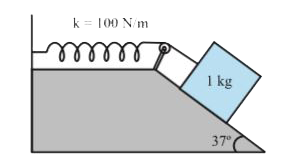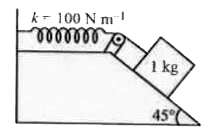A 1kg block situated on a rough incline is connected to a spring of spring constant 100Nm−1 as shown in figure,. The block is released from rest with the spring in the unstretched position. The block moves 10cm down the incline before coming to rest. Find the coefficient of friction between the block and the incline. Assume that the spring has negligible mass and the pulley is frictionless.

As is clear from figure,
R=mgcosθ,F=μR=μmgcosθ
Net force on the block doen the incline
=msinθ−F=mgsingθ−μmgcosθ=mg(sinθ−μcosθ)
distance moved, x=10cm=0.1m.
In equilibrium, work done = P.E. of stretched spring
mg(sinθ−μcosθ)x=12Kx2
2mg(sinθ−μcosθ)x=Kx
2×1×10(sin37∘−μcos37∘)=100×0.1
20(0.601−μ.0.798)=10∴μ=0.126
Topper's Solved these Questions
- BOOK - PRADEEPCHAPTER - WORK, ENERGY AND POWEREXERCISE - Additional Exercises3videos
WORK, ENERGY AND POWER
- BOOK - PRADEEPCHAPTER - WORK, ENERGY AND POWEREXERCISE - higher order thinking skills10videos
WORK, ENERGY AND POWER
- BOOK - PRADEEPCHAPTER - WORK, ENERGY AND POWEREXERCISE - Advanced Problems For Competitions20videos
WORK, ENERGY AND POWER
- BOOK - PRADEEPCHAPTER - THERMODYNAMICSEXERCISE - Assertion- Reason Type Questions19videos
THERMODYNAMICS
Similar Questions
A and B are two particles having the same mass m. A is moving along X-axis with a speed of 10ms−1 and B is at rest. After undergoing a perfectly elastic collision with B, particle A gets scattered through an angle of 30∘. What is th edirection of motion of B, and the speeds of A and B, after the collision?
08:19View SolutionTwo balls A and B of masses 0.3 kg and 0.2 kg respectively are moving along positive X-axis and negaive X-axis with velocities 2.0 m / s. They collide and thereafter move in the directions opposite to their original directions. Find the velocities of A and B after collision. Also, calculate total K.E. of the ball before and after collision.
03:47View SolutionTwo identical 5 kg blocks are moving with same speed of 2m/s towards eachother along a frictionless horizontal surface. The two blocks collide, stick together and come to rest. Consider the two blocks as a system. Caluculate work done by (i) external forces (ii) internal forces.
02:54View SolutionAssertion : Internal energy of an ideal gas does not depend upon volume of the gas.
Reason : This is because internal energy of ideal gas depends only on temperature of gas.View Solutiona. A 2-kg situated on a smooth fixed incline is connected to a spring of negligible mass, with spring constant k=100Nm^-1 , via a frictionless pulley. The block is released from rest when the spring is unstretched. How far does the block moves down the incline before coming (momentarily) to rest? What is its acceleration at its lower point? b. The experiment is repeated on a rough incline. If the block is observed to move 0.20m down along the incline before it comes to instantaneous rest, calculate the coefficient of kinetic friction.
06:59View SolutionA block of mass 8 kg is released from the top of an inclined smooth surface as shown in figure. If spring constant of spring is 200 Nm^(-1) and block comes to rest after compressing spring by 1 m then find the distance travelled by block before it comes to rest
View SolutionA block of mass 4 kg is released from the top of an inclined smooth surface as shown in figure If spring constant of spring is 100M/m and block comes to rest after compressiong spring by 1 m, find the distance travelled by the block before it comes t o rest.
 07:46View Solution
07:46View SolutionA 1 kg block situated on a rough incline is connected to a spring of spring constant 100 Nm^(-1) as shown in Fig. 6.17. The block is released from rest with the spring in the unstreched position. The block moves 10 cm down the incline before coming to rest. Find the coefficient of friction between the block and the incline. Assume that the spring has a negligible mass and the pulley is frictionless.
View SolutionA 1 kg block situated on a rough incline is connected to a spring of spring constant 100Nm−1 as shown in Fig. 6.17. The block is released from rest with the spring in the unstreched position. The block moves 10 cm down the incline before coming to rest. Find the coefficient of friction between the block and the incline. Assume that the spring has a negligible mass and the pulley is frictionless.
 04:30View Solution
04:30View SolutionA 1 kg block situated on a rough incline is connected to a spring of spring constant 100 Nm^(-1) as shown in Fig. 6.17. The block is released from rest with the spring in the unstreched position. The block moves 10 cm down the incline before coming to rest. Find the coefficient of friction between the block and the incline. Assume that the spring has a negligible mass and the pulley is frictionless.
View SolutionA 1kg block situated on a rough incline is connected to a spring of spring constant 100Nm^(-1) as shown in figure,. The block is released from rest with the spring in the unstretched position. The block moves 10cm down the incline before coming to rest. Find the coefficient of friction between the block and the incline. Assume that the spring has negligible mass and the pulley is frictionless.
View SolutionFor the given system, initially the spring is unstretched and the block is at rest. There is no friction in pulley. If the block is relased at such conditions, find the maximum enlogation of the spring.
 03:46View Solution
03:46View SolutionA 1 kg block situated on a rough incline is connected to a spring constant 100Nm−1 as shown in figure . The block is released from rest with the spring in the unstretched position . The block moves 10 cm down the incline before coming to rest . Find the coefficient of friction between the block and the incline .Assume that the spring has a negligible mass and the pulley is frictionless.
 12:08View Solution
12:08View SolutionA 1kg block situated on a rough incline is connected to a spring of spring constant 100Nm^(-1) as shown in figure,. The block is released from rest with the spring in the unstretched position. The block moves 10cm down the incline before coming to rest. Find the coefficient of friction between the block and the incline. Assume that the spring has negligible mass and the pulley is frictionless.
03:25View SolutionA 1 kg block situated on a rough incline is connected to a spring of negligible mass having spring constant 100Nm−1 as shown in the figure.The block is released from rest with the spring in the unstretched position. The block moves 10 cm down the incline before coming to rest. The coefficient of friction between the block and the incline is (Take g=10ms−2 and assume that the pulley is frictionless)
 03:13View Solution
03:13View Solution

